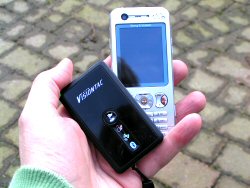Note that the Visiontac VGPS-900 data logger has also been marketed as the Columbus V-900.
In general, this device has proved to be really easy to look after and use in
the field. It comes with a cable that enables you to charge it from a USB slot.
It also comes with a converter that lets you to charge it from a standard car
power socket. I nearly always charge mine by plugging it into a USB port on my
computer when I am at work. On a full charge, the battery will run for something
like a day, but I've never done any tests.

Using it in the field is easy. I generally switch mine on when I leave the house
and when I want to make a record I take it from my pocket:
- press the voice button;
- wait a second until I hear a beep;
- say whatever I want to say; and
- release the button.
That's it - a record is in the making!
When I am out I often make records without breaking my stride, yet alone
stopping, and there's no more fumbling with notebook, maps, GPS or apps.
I usually keep my Visiontac in my pocket in a protective soft cover that comes
with it. The device is really tiny - dwarfed by my mobile phone - and keeping
both the device and my phone in the same pocket of my jeans is no problem (the
Visiontac's case protecting both phone and data logger). When
I drive, I often keep the device on a lanyard around my neck. Then when I see a
buzzard - or something else I want to record - I find the voice button by touch (easy
once you've done it a few times), move the device close to my mouth and record
what I've seen. A friend of mine who was a traffic policeman for many years
has assured me that this is legal - unlike using a mobile phone - because I am
not engaged in a two-way conversation. It's no more dangerous than
changing radio stations.
I have had one or two minor problems with the device which are worth reporting,
if for no other reason than it might save someone else some time and pain learning
about them.

Firstly I have noticed that ocassionally the voice tag I make is clipped or
otherwise attenuated. Sometimes this is bad enough that I can't make out what I
recorded and so lose the record. For me, this probably happens around 1 time in
100. This may be to do with the quality of the micro-SD I bought - cheaper
quality ones don't handle the throughput of data so well and recording sound
obviously generates a fair amount of data - and friends who also use the device
have not had the problem. You don't need a huge micro-SD card - with my 2GB card I could probably record
for a whole year on that without taking stuff off. Go for quality over size.
Secondly if you make a voice
tag and then create another one immediately afterwards, the new voice tag
completely replaces the one you've just made. So for example if I made a tag
like this 'Two Gatekeepers' and then immediately made another tag like this
'Both males', then I would lose the first and all I would have when I tried to
make the record was 'Both males'. Not much use. I learned this the hard way. I
then did some experimenting and found that it appears to occur when the gap
between recording is less than about 5 seconds and you haven't moved. Generally
if you've waited more than about five seconds or moved more than about 5 metres,
you will get both voice tags. So if you need to amend something you've said
immediately, then either wait, move or replace the whole thing (e.g. in my
example, my second tag should have been 'Correction two Gatekeepers both male').
Visiontac really made this device for hikers etc who would want to add the
ocasssional voice tag e.g. 'I'm at the top of Ben Nevis!'. By using it for
biological recording, we are really pushing the feature to its limits so its not
surprising that there are one or two minor glitches.